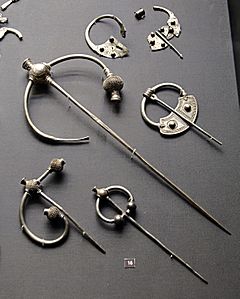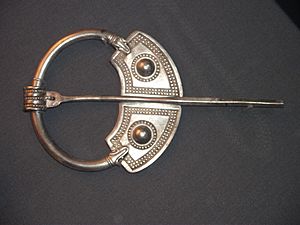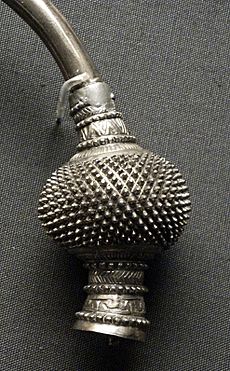Penrith Hoard facts for kids
Quick facts for kids Penrith Hoard |
|
|---|---|

Brooches found in 1830 (largest) and 1989
|
|
| Material | Silver |
| Size | Several silver penannular brooches |
| Created | 10th century |
| Period/culture | Viking |
| Discovered | Newbiggin Moor, Near Penrith in 1785-1989 |
| Present location | British Museum, London |
The Penrith Hoard is a collection of valuable silver items, mostly fancy pins called penannular brooches. These items are from the 10th century, a time when Vikings were active in Britain. They were found near Penrith in Cumbria, England, and are now kept at the British Museum in London.
The first big brooch was found way back in 1785. Another one turned up in 1830. Most of the other items were found much later, in 1989, by archaeologists. It's not totally clear if all these finds were buried at the same time. However, experts believe the brooches probably were. They think the hoard was hidden around the year 930.
Discovering the Penrith Hoard
The first items from the hoard were found in a place already called the "Silver Field" on Newbiggin Moor. A young boy found the earliest surviving piece in 1785. The field's name suggests that other silver items might have been found there before, but they are now lost.
In 1830, another smaller brooch was discovered. Even though its exact spot isn't known, people believe it also came from the "Silver Field." Sometimes, a hoard gets "dispersed" or spread out. This can happen when farming tools like ploughs move some items before they are found.
Later, in 1989, archaeologists dug at the same spot. They found more silver items. This proved that it was a spread-out hoard, not just a single lost brooch. They found two groups of items in nearby fields. One group had five Viking brooches and pieces of two more. The other group had over fifty items. These included coins, silver bars called ingots, jewelry, and hacksilver. Hacksilver is jewelry or other silver pieces that have been chopped up. All these items were from a similar time period.
The brooches were officially declared "treasure trove" in 1990. This means they were old, valuable, and their original owner couldn't be found. The British Museum received the brooches in 1991 and the rest of the hoard in 2009.
Viking Brooches and Their History
The penannular brooch was originally a simple pin used to fasten clothes. People in Roman Britain often wore them. Over time, these brooches became very fancy and decorative. In Ireland and Scotland, they showed a person's high status. Both men and women wore them. They were made from valuable metals and often had jewels.
When the Vikings came to the British Isles, they started wearing these brooches too. But the Vikings often preferred them in plain silver. The "thistle" and "bossed" types found in the Penrith Hoard were very popular styles. These designs grew out of older Celtic styles.
Some experts think the hoard might be linked to events in 927. The items in the hoard suggest a connection to Ireland. In 927, the kings of Strathclyde and Scotland met with Athelstan near Penrith. Athelstan was a powerful English king. A troublesome Norse-Gael king from Dublin, named Gofraid ua Ímair, was also in the area with his army. Athelstan made the other kings promise to stop associating with pagan Vikings like Gothfrith. Gothfrith then tried to attack York. He was chased out and went back to Ireland. The hoards might have been hidden during these events.
Items Found in the Hoard

The large thistle brooch found in 1785 went to the Leverian Museum, a private museum in London. In 1787, a picture of it was published. It was wrongly claimed to be a symbol of the Knights Templar. The British Museum bought this brooch in 1909.
The brooch found in 1830 is the largest one shown in the main picture of the hoard. It came to the museum in 1904. One end of this brooch is missing, and its pin is 52 centimeters long.
In 1989, two more incomplete thistle brooches were found. Pieces from three "bossed-type" brooches were also discovered. These are seen with the 1830 brooch in the group picture. The most complete brooch from the 1989 group has runic writing scratched on the back of its hoop. The other two have a pattern called interlace around the raised bumps on their ends.
It is very likely that all these brooches were originally buried together. They were probably spread out and damaged over time by ploughing in the fields.


